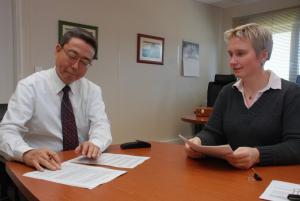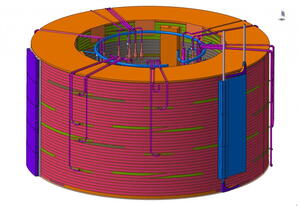Central solenoid conductor signed away
This week, signatures on the ITER Organization's 30th Procurement Arrangement were completed in Barcelona. Following signature by the Japanese Domestic Agency and the ITER Organization, the Procurement Arrangement for the central solenoid conductor was endorsed at the European Domestic Agency, Fusion for Energy.
With the completion of this Procurement Arrangement, the Japanese Domestic Agency will begin procurement activities with industry for the supply of 122 tonnes—some 42 kilometres stretched end-to-end—of central solenoid conductor. The conductors will be produced in unit lengths of either 605 or 905 metres; a 1 km-long facility has been constructed in Japan at Nippon Steel in Kyushu for the jacketing of the central solenoid cable and for the Japanese share of the ITER toroidal field cable.
The central solenoid is the 1,000-tonne central pillar of the ITER device. Thirteen metres tall, it will be supported at its bottom by the 18 toroidal field magnets that frame the vacuum vessel. The torus shape of the ITER Tokamak is frequently compared to a donut; the central solenoid will completely occupy the central "donut hole."
Inside the central solenoid modules, the conductor will be coiled tightly into flat layers called pancakes, each layer having 14 turns. One conductor unit length of 905 metres will be used to wind six layers of pancake (a hexapancake); a shorter unit length of 605 metres will form four layers (a quadpancake). A central solenoid module will be composed of both hexas (6) and one quad for a total of 40 pancakes. Six central solenoid modules will make up the central solenoid column.
As in all tokamaks, the ITER central solenoid will fulfil the major role of inducing the current in the plasma. In ITER, it has been designed to provide the maximum possible magnetic flux to allow 1,000 second-long plasma pulses. Like in induction cooking—where varied current in the embedded solenoid in the stove induces current directly into the cooking pot—the large flux variation across the six central solenoid modules will induce 15 MA of current in the plasma. Each of the modules will be fed with different currents; variations in current will allow the central solenoid to assist in the shaping of the plasma for better confinement, in conjunction with the poloidal field coils.



